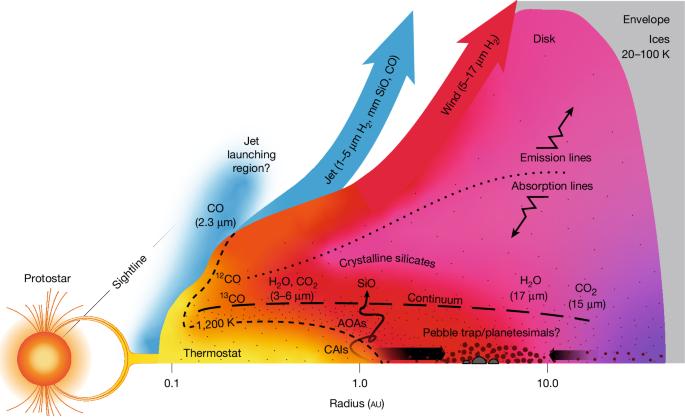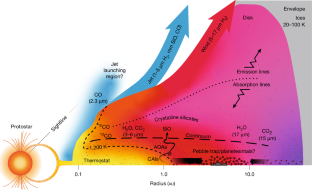在嵌入的原行星盘中检测到难熔固体凝结
IF 48.5
1区 综合性期刊
Q1 MULTIDISCIPLINARY SCIENCES
引用次数: 0
摘要
理论上,我们太阳系中的类地行星和小天体是由星际固体与岩石固体混合而成的,岩石固体是由高温冷却气体沉淀而成的1,2。第一批高温矿物从这个气态储层中重新凝聚,开始了行星形成的时钟。然而,这种初始热气体的产生机制及其在其他系统中对行星形成的重要性尚不清楚。在这里,我们报告了对这个t = 0时刻的天文探测,捕捉到了一个新的行星系统开始组装的基石。詹姆斯·韦伯太空望远镜(JWST)和阿塔卡马大型毫米波阵列(ALMA)在红外和毫米波波段观测到年轻的原恒星HOPS-315,揭示了一个温暖的一氧化硅气体和晶体硅酸盐矿物的储层,位于恒星2.2 au内的一个圆盘的大气中,与毫米SiO射流物理隔离。与快速晶粒生长的冷凝模型和圆盘结构模型的比较表明,形成的难熔固体类似于我们太阳系中的固体。我们的结果表明,内盘区域的环境受到星际固体升华和随后来自该气藏的难熔固体再冷凝的影响,其时间尺度与我们太阳系的难熔冷凝相当。本文章由计算机程序翻译,如有差异,请以英文原文为准。


Refractory solid condensation detected in an embedded protoplanetary disk
Terrestrial planets and small bodies in our Solar System are theorized to have assembled from interstellar solids mixed with rocky solids that precipitated from a hot, cooling gas1,2. The first high-temperature minerals to recondense from this gaseous reservoir start the clock on planet formation3,4. However, the production mechanism of this initial hot gas and its importance to planet formation in other systems are unclear. Here we report the astronomical detection of this t = 0 moment, capturing the building blocks of a new planetary system beginning its assembly. The young protostar HOPS-315 is observed at infrared and millimetre wavelengths with the James Webb Space Telescope (JWST) and the Atacama Large Millimeter Array (ALMA), revealing a reservoir of warm silicon monoxide gas and crystalline silicate minerals low in the atmosphere of a disk within 2.2 au of the star, physically isolated from the millimetre SiO jet. Comparison with condensation models with rapid grain growth and disk structure models suggests the formation of refractory solids analogous to those in our Solar System. Our results indicate that the environment in the inner disk region is influenced by sublimation of interstellar solids and subsequent refractory solid recondensation from this gas reservoir on timescales comparable with refractory condensation in our own Solar System. Observations at infrared and millimetre wavelengths of the young protostar HOPS-315 show a gaseous disk captured at the point at which solids are first starting to condense, the t = 0 for planet formation.
求助全文
通过发布文献求助,成功后即可免费获取论文全文。
去求助
来源期刊

Nature
综合性期刊-综合性期刊
CiteScore
90.00
自引率
1.20%
发文量
3652
审稿时长
3 months
期刊介绍:
Nature is a prestigious international journal that publishes peer-reviewed research in various scientific and technological fields. The selection of articles is based on criteria such as originality, importance, interdisciplinary relevance, timeliness, accessibility, elegance, and surprising conclusions. In addition to showcasing significant scientific advances, Nature delivers rapid, authoritative, insightful news, and interpretation of current and upcoming trends impacting science, scientists, and the broader public. The journal serves a dual purpose: firstly, to promptly share noteworthy scientific advances and foster discussions among scientists, and secondly, to ensure the swift dissemination of scientific results globally, emphasizing their significance for knowledge, culture, and daily life.
 求助内容:
求助内容: 应助结果提醒方式:
应助结果提醒方式:


